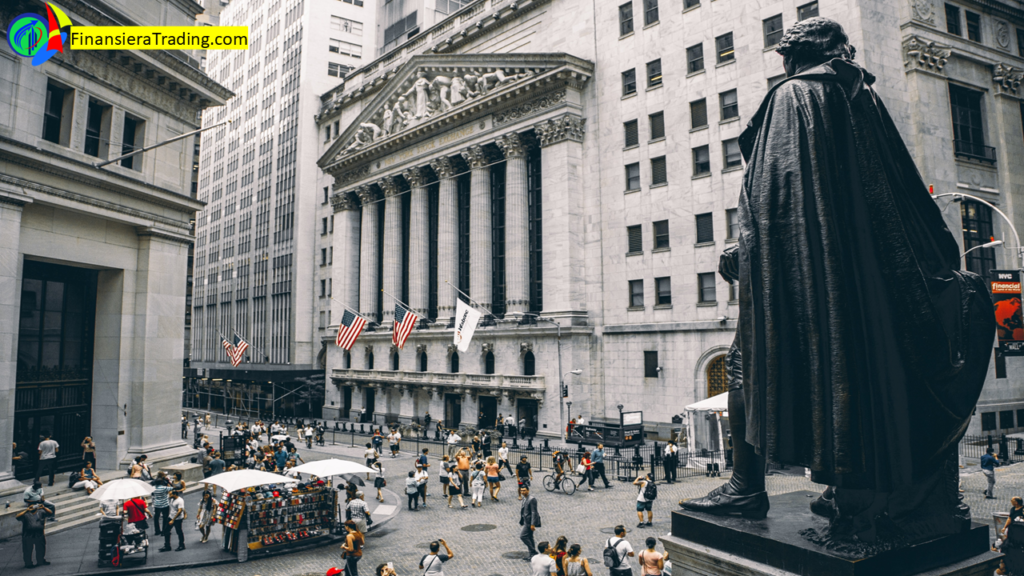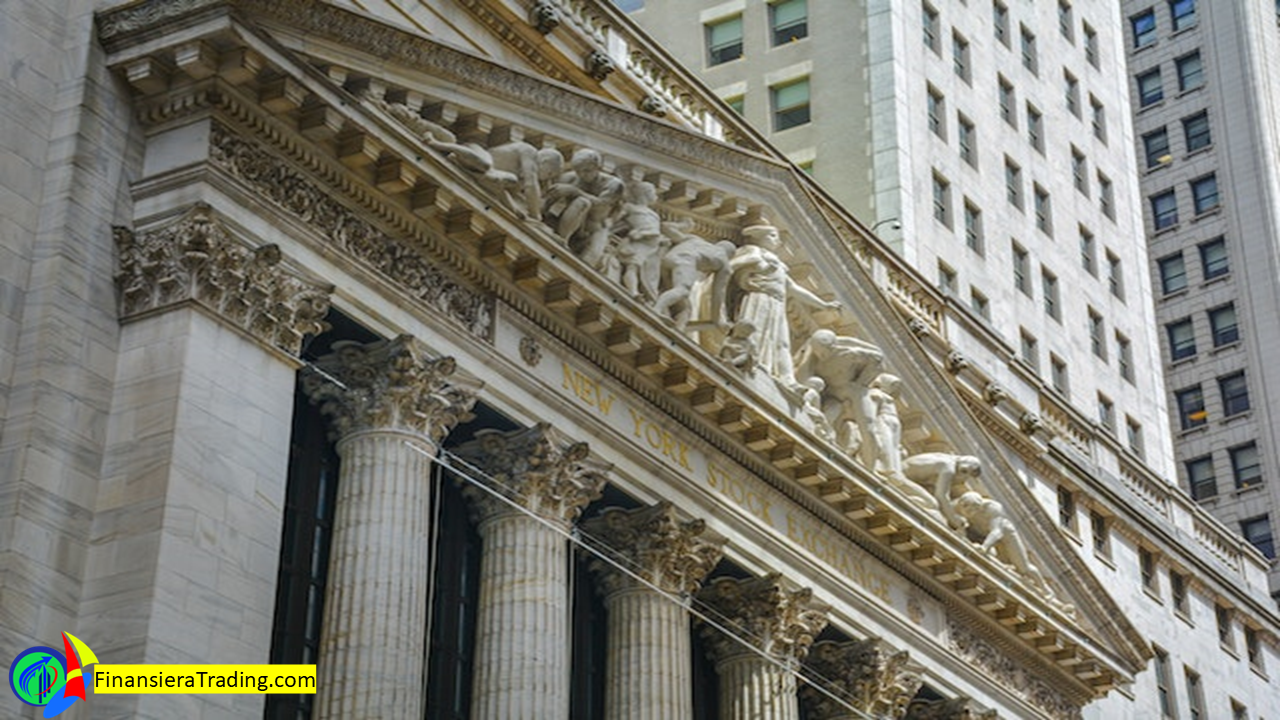The New York Stock Exchange (NYSE) is not just a name; it’s an emblem of global finance. As one of the world’s most renowned financial marketplaces, the NYSE has been at the epicenter of economic evolution for over two centuries. But what makes it so influential? In this blog post, we’ll delve deep into the intricacies of the NYSE, exploring its structure, trading mechanisms, listed companies, and much more. From its historical significance to recent trends and developments, get ready for a comprehensive journey into the heart of Wall Street’s crown jewel.

NYSE; Structure and Organization
Have you ever wondered how The New York Stock Exchange (NYSE) operates so seamlessly? Let’s dive into the heart of Wall Street and uncover the structure and organization of this financial giant.
At its core, the NYSE isn’t just a building where stocks are traded. It’s a complex system, meticulously organized to ensure that millions of transactions happen smoothly every single day. So, how is it all set up?
1. The Governing Body:
The NYSE is overseen by a board of directors. This team ensures that the exchange runs efficiently and that it adheres to all regulatory standards. They’re the decision-makers, setting the strategic direction for the NYSE.
2. Trading Floors and Designated Market Makers (DMMs):
Unlike many other stock exchanges, The New York Stock Exchange still has a physical trading floor. Here, human traders work alongside electronic systems. The DMMs play a pivotal role, overseeing the trading of specific stocks and ensuring there’s a fair and orderly market for them.
3. Brokers and Dealers:
These are the folks you might picture when you think of The New York Stock Exchange – bustling around, making deals, and shouting orders. They represent individual investors, institutions, and even themselves, buying and selling stocks based on market conditions.
4. Electronic Trading:
While the hustle and bustle on the floor is iconic, a significant portion of trading on the NYSE is done electronically. Advanced systems allow for millions of trades to be executed in mere seconds, catering to the modern, fast-paced world of finance.
5. Regulatory Oversight:
Ensuring that everything is above board, the NYSE has its own regulatory body. This team keeps a close eye on all activities, making sure that every transaction adheres to the rules and that investors are protected.
In essence, The New York Stock Exchange is a blend of tradition and innovation. Its structure and organization have evolved over the years, but its commitment to providing a transparent and efficient marketplace remains unchanged. So, the next time you hear a company’s stock is being traded on the NYSE, you’ll have a clearer picture of the intricate dance happening behind the scenes. (FinansieraTrading.com); nytimes
Trading Mechanisms
Ever been curious about how stocks actually change hands on The New York Stock Exchange (NYSE)? Let’s demystify the trading mechanisms that keep this financial behemoth ticking.
At first glance, the NYSE might seem like a chaotic whirlwind of numbers and shouts. But beneath the surface, it’s a finely-tuned machine, designed to ensure every trade is executed swiftly and fairly. So, how does trading on the NYSE actually work?
1. Floor Trading:
Yes, in this digital age, The New York Stock Exchange still values the human touch. On the trading floor, brokers interact directly with Designated Market Makers (DMMs). They negotiate prices, shout out orders, and seal deals with a handshake. It’s old-school, but it works!
2. Electronic Trading:
Welcome to the future! The majority of trades on the NYSE are now done electronically. With just a few clicks, orders are matched and executed in milliseconds. It’s efficient, transparent, and perfect for today’s fast-paced trading environment.
3. The Opening and Closing Bells:
Ever heard that iconic bell ringing on TV? That’s The New York Stock Exchange signaling the start and end of the trading day. It’s not just ceremonial; it helps regulate the flow of trades and ensures there’s an orderly opening and closing to the market.
4. Continuous Trading:
From the opening bell to the closing bell, the NYSE is abuzz with activity. Stocks are continuously bought and sold, with prices fluctuating based on supply and demand. It’s this dynamic that keeps the market vibrant and investors on their toes.
5. Circuit Breakers:
To protect investors and the market, the NYSE has safety mechanisms in place. If stock prices swing too wildly, trading can be temporarily halted. Think of it as a “time-out” to let traders catch their breath and prevent panic selling.
In a nutshell, trading on The New York Stock Exchange is a blend of tradition and technology. Whether it’s brokers negotiating on the floor or algorithms matching orders electronically, the goal is the same: to provide a fair, transparent, and efficient marketplace for all.
Listed Companies
When we talk about The New York Stock Exchange (NYSE), we’re talking about a stage where some of the world’s most prominent companies come to shine. But what does it mean for a company to be “listed” on the NYSE, and who are these corporate giants? Let’s dive in.
1. What Does “Listed” Mean?
Being “listed” on The New York Stock Exchange is like getting a VIP pass to the world of finance. It means a company has met specific criteria and is allowed to trade its shares on this prestigious platform. It’s a badge of honor, signaling trust and credibility to investors.
2. The Elite Club:
The NYSE isn’t for everyone. Only companies that meet stringent financial and governance standards get to be listed. Think of it as an exclusive club where only the best get in. And once they’re in, they enjoy increased visibility and access to capital.
3. A Global Melting Pot:
While the NYSE might be based in New York, its reach is global. Companies from all over the world, from diverse sectors like technology, healthcare, finance, and energy, call the NYSE home. It’s a testament to the exchange’s global influence and appeal.
4. The Big Names:
Ever heard of Coca-Cola, IBM, or Disney? Of course, you have! These are just a few of the household names listed on The New York Stock Exchange. When you invest in stocks on the NYSE, you’re investing in some of the world’s most established and influential companies.
5. The Rising Stars:
It’s not just about the established giants. The NYSE is also a launchpad for up-and-coming companies looking to make their mark. These newcomers bring fresh ideas and innovations, adding vibrancy to the market.
6. The Criteria:
So, how does a company get listed on the NYSE? There are financial benchmarks to hit, like a minimum earnings threshold. Companies also need to adhere to the NYSE’s governance and ethical standards. It’s a rigorous process, but it ensures that only the best get to trade on this esteemed platform.
In essence, The New York Stock Exchange is a gathering place for the world’s top companies. Whether they’re century-old institutions or modern disruptors, they come to the NYSE to grow, innovate, and shape the future.
Economic Impact
When we mention The New York Stock Exchange (NYSE), it’s not just about stocks and trades. The NYSE is a powerhouse that drives economies, shapes industries, and influences global financial trends. But what’s the real economic impact of this iconic institution? Let’s break it down.

1. A Global Financial Hub:
The NYSE isn’t just a stock exchange; it’s a global financial epicenter. Every day, billions of dollars change hands, making it one of the world’s most liquid markets. This liquidity ensures that businesses can raise capital efficiently, fueling growth and innovation.
2. Job Creation:
Think of all the companies listed on The New York Stock Exchange. Now, think of all their employees. The NYSE indirectly supports millions of jobs worldwide, from tech startups in Silicon Valley to manufacturing giants in the Midwest.
3. Boosting Investor Confidence:
Being listed on the NYSE is a mark of credibility. It signals to investors that a company meets stringent financial and ethical standards. This trust is crucial, encouraging more people to invest and driving economic growth.
4. Setting Global Trends:
The performance of stocks on The New York Stock Exchange often sets the tone for global markets. If the NYSE has a good day, markets worldwide tend to follow suit. It’s a ripple effect that showcases the NYSE’s global influence.
5. Fueling Innovation:
Many of the funds raised on the NYSE go into research and development. This investment drives technological advancements, medical breakthroughs, and other innovations that shape our future.
6. Supporting Retirement:
Ever thought about your 401(k) or pension plan? Chances are, some of that money is invested in companies listed on The New York Stock Exchange. The NYSE plays a pivotal role in helping people secure their financial futures.
In a nutshell, The New York Stock Exchange is more than just a place where stocks are traded. It’s a driving force behind global economies, a catalyst for growth, and a beacon of opportunity. The economic impact of the NYSE is profound, touching every corner of the globe and every aspect of our lives.
Technological Advancements
In the bustling heart of Wall Street lies The New York Stock Exchange (NYSE), an institution that’s been around for over two centuries. But don’t let its age fool you. The NYSE has consistently been at the forefront of technological advancements, revolutionizing the way we trade and invest. Let’s explore how technology and the NYSE have evolved hand in hand.
1. From Paper to Pixels:
Remember the days when traders would shout orders across the floor, scribbling on paper slips? Those days are long gone. Today, The New York Stock Exchange harnesses cutting-edge electronic trading systems, ensuring orders are matched and executed in milliseconds.
2. Global Connectivity:
Thanks to technology, the NYSE is no longer bound by its physical location. Investors from all over the world can access the market in real-time, making it a truly global exchange.
3. Enhanced Security:
With the rise of cyber threats, the NYSE has invested heavily in cybersecurity measures. Advanced encryption and multi-factor authentication ensure that trades are secure and investor data is protected.
4. Real-time Data Analysis:
The NYSE processes vast amounts of data every second. Advanced analytics tools help investors make informed decisions by providing real-time insights, trends, and forecasts.
5. AI and Machine Learning:
The New York Stock Exchange is leveraging artificial intelligence to detect unusual trading patterns, predict market movements, and offer personalized insights to investors. It’s like having a super-smart assistant guiding your investment decisions.
6. Sustainable Trading:
Did you know the NYSE is going green? Technological advancements are also driving sustainability initiatives, from reducing paper waste to optimizing energy consumption in data centers.
7. Virtual Reality and Augmented Reality:
Imagine walking through a virtual trading floor or visualizing stock trends in 3D. The NYSE is exploring VR and AR technologies to offer immersive trading experiences and educational tools.
While The New York Stock Exchange is steeped in tradition, it’s always had an eye on the future. By embracing technological advancements, the NYSE ensures it remains relevant, efficient, and ahead of the curve, setting the standard for stock exchanges worldwide.
Regulations and Oversight
The New York Stock Exchange (NYSE) isn’t just a hub of financial activity; it’s a beacon of trust and integrity in the global financial landscape. But how does the NYSE maintain this reputation? The answer lies in its stringent regulations and robust oversight mechanisms. Let’s delve into the safeguards that keep the NYSE running smoothly and transparently.
1. Setting the Gold Standard:
The NYSE isn’t just any stock exchange; it’s a benchmark for global financial markets. The regulations set by the NYSE often inspire best practices worldwide, ensuring that markets operate fairly and transparently.
2. Protecting Investors:
At the heart of The New York Stock Exchange’s regulatory framework is the protection of investors. By ensuring that companies disclose accurate financial information and adhere to ethical standards, the NYSE gives investors the confidence to trade and invest.
3. Continuous Monitoring:
The NYSE employs advanced surveillance systems that monitor trading activity in real-time. This vigilance helps detect and prevent market manipulation, insider trading, and other unethical practices.
4. Collaboration with Regulatory Bodies:
The NYSE works hand in hand with external regulatory agencies, such as the Securities and Exchange Commission (SEC). This collaboration ensures that regulations are up-to-date, comprehensive, and in line with federal laws.
5. Strict Listing Criteria:
Not every company can list on The New York Stock Exchange. The NYSE has rigorous listing criteria that companies must meet, from financial health to corporate governance standards. This scrutiny ensures that only credible and stable companies trade on the exchange.
6. Enforcement and Accountability:
Regulations are only as good as their enforcement. The NYSE has a dedicated enforcement division that investigates breaches and takes corrective actions. Companies or traders that violate the rules face penalties, ensuring accountability.
7. Ongoing Education:
The NYSE believes in the power of knowledge. It regularly conducts educational programs and workshops for traders, investors, and listed companies. This initiative ensures that all stakeholders are aware of the latest regulations and best practices.
In essence, The New York Stock Exchange is more than just a place for buying and selling stocks. It’s a fortress of trust, built on a foundation of stringent regulations and oversight. By upholding these standards, the NYSE ensures that it remains a trusted and reliable marketplace for investors worldwide.
Comparison with Other Stock Exchanges
The New York Stock Exchange (NYSE) stands tall as one of the world’s leading financial marketplaces. But how does it stack up against other major stock exchanges? Let’s dive into a comparative analysis to understand the unique strengths and characteristics of the NYSE in the global arena.
1. Market Capitalization:
The NYSE is often touted as the largest stock exchange by market capitalization. With numerous multinational corporations calling it home, the NYSE’s total market cap surpasses many of its counterparts, including the Tokyo Stock Exchange and the London Stock Exchange.
2. Trading Volume:
When it comes to trading volume, The New York Stock Exchange is a powerhouse. Its daily trading activity often exceeds that of other exchanges, showcasing its prominence in the global financial ecosystem.
3. Global Reach:
While exchanges like the Shanghai Stock Exchange or the Hong Kong Stock Exchange dominate their regional markets, the NYSE’s influence is truly global. Companies from all continents aspire to list on the NYSE, making it a melting pot of global enterprises.
4. Technological Advancements:
Compared to other stock exchanges, the NYSE has been at the forefront of technological innovation. From electronic trading systems to AI-driven analytics, the NYSE leverages technology to offer a seamless trading experience.
5. Regulatory Framework:
The regulatory environment of The New York Stock Exchange is often considered more stringent than many other exchanges. This robust framework ensures transparency, fairness, and investor protection, setting the NYSE apart.
6. Listing Diversity:
While exchanges like the NASDAQ are known for tech companies, the NYSE boasts a diverse range of industries. From energy giants to retail conglomerates, the NYSE offers a broad spectrum of investment opportunities.
7. Historical Significance:
The NYSE’s rich history, dating back to 1792, gives it an edge in terms of legacy and prestige. Few exchanges, like the Frankfurt Stock Exchange, share such a deep-rooted history.
While many stock exchanges offer unique advantages and cater to specific regional or sectoral needs, The New York Stock Exchange stands out as a global leader. Its blend of size, diversity, technology, and regulation makes it a preferred choice for companies and investors alike.
Recent Trends and Developments
The world of finance is ever-evolving, and The New York Stock Exchange (NYSE) is no exception. As a pivotal player in the global financial landscape, the NYSE continually adapts to the changing tides of the industry. Let’s explore some of the recent trends and developments that have shaped the NYSE’s trajectory.
1. Embracing Digital Assets:
Cryptocurrencies and blockchain technology have taken the financial world by storm. Recognizing this shift, The New York Stock Exchange has made significant strides in integrating digital assets, from launching Bitcoin futures to exploring blockchain-based trading platforms.
2. ESG Investing:
Environmental, Social, and Governance (ESG) investing is gaining traction. The NYSE has responded by introducing ESG-focused indices and facilitating the listing of green bonds, catering to the growing demand for sustainable investment options.
3. SPAC Boom:
Special Purpose Acquisition Companies (SPACs) have become a popular alternative to traditional IPOs. The NYSE has witnessed a surge in SPAC listings, offering companies a novel route to go public.
4. Enhanced Trading Technology:
To ensure seamless trading experiences, The New York Stock Exchange has rolled out advanced trading algorithms and high-frequency trading systems, reducing latency and enhancing market liquidity.
5. Focus on Small and Medium Enterprises (SMEs):
Understanding the potential of SMEs, the NYSE has introduced tailored listing criteria and support mechanisms, making it easier for smaller companies to access public markets.
6. Global Expansion:
While the NYSE’s roots are firmly planted in Wall Street, its vision is global. Recent partnerships and collaborations with foreign exchanges underscore the NYSE’s commitment to expanding its international footprint.
7. Pandemic Response:
The COVID-19 pandemic posed unprecedented challenges. The NYSE showcased resilience by swiftly transitioning to electronic trading and implementing safety protocols, ensuring uninterrupted market operations.
In a nutshell, The New York Stock Exchange is not just reacting to industry trends; it’s setting them. By staying ahead of the curve and proactively adapting to market dynamics, the NYSE reaffirms its position as a global financial powerhouse.
Conclusion
The New York Stock Exchange (NYSE) is more than just a financial institution; it’s a testament to the ever-evolving world of finance, innovation, and global collaboration. From its humble beginnings in 1792 to its current status as a global powerhouse, the NYSE has consistently demonstrated resilience, adaptability, and foresight.
As we’ve explored in this post, the NYSE isn’t just about trading stocks. It’s about setting global standards, fostering innovation, and driving economic growth. The recent trends and developments highlight the NYSE’s commitment to staying ahead of the curve, ensuring that it remains relevant and influential in the face of changing market dynamics.
For investors, traders, and financial enthusiasts, the NYSE offers a window into the future of finance. Its continued emphasis on technology, sustainability, and global expansion paints a promising picture for the years to come.
In closing, The New York Stock Exchange is not just a symbol of Wall Street; it’s a beacon for global finance. As it continues to shape the financial landscape, one thing is certain: the NYSE will remain at the heart of global economic progress.




